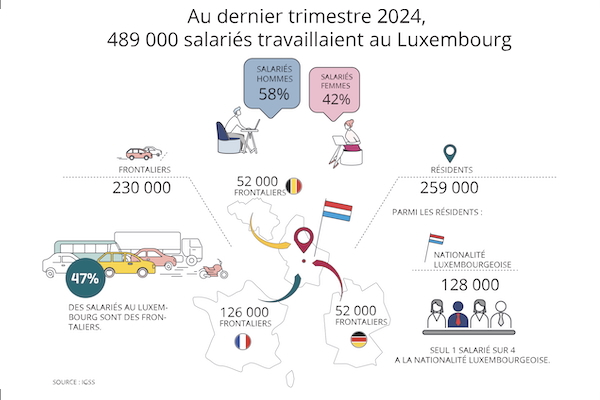 Credit: Statec
Credit: Statec
Ahead of Labour Day, Thursday 1 May 2025, Luxembourg's national statistics portal, STATEC, published a report on a variety of figures concerning workers in Luxembourg.
Of the 489,000 employees in Luxembourg, 47% are cross-border workers (126,000 of them from France, 52,000 from Germany and 52,000 from Belgium). 58% of Luxembourg employees are men, 42% are women. Only one in four employees holds Luxembourgish nationality.
STATEC reported that Luxembourg stands out for its high salaries, ranking second in the European Union with a median hourly wage of €24 and that the gender pay gap also showed a reversed trend compared to most of Europe, with the median hourly wage for women being 11% higher than that of men, making Luxembourg a notable exception.
While the overall employment rate fell slightly in 2024, with growth slowing to 1% overall and to 0.5% outside the public sector, female employment continued to grow, reaching 67.0% (66.8% in 2023). However, the male employment rate fell from 73.6% to 71.9% over the same period. The employment rate for young people aged fifteen to 24 was 29% and for people aged 50 and over was 36.1%. Sunday work remains common in the Grand Duchy, with around one in four employees working on Sundays, either regularly or occasionally.
STATEC’s report revealed that health plays a key role in employment, with a large majority of residents (80%) reporting that they feel in good health, influencing their ability to participate in the labour market. However, STATEC noted that there is a clear correlation between self-rated health and the employment rate. According to the report, people who do not feel restricted in their daily activities have a high employment rate (74% of men and 69% of women), yet men who feel somewhat restricted in their activities have a slightly lower employment rate (67%), while the employment rate for women remains at the same level (69%). Moreover, people severely restricted in their daily activities have a significantly lower employment rate, with only 41% of men and 37% of women employed, highlighting the significant challenges they face in maintaining regular professional activity.








